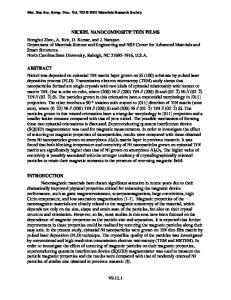Bioinspired Inorganic/polymer Thin Films
- PDF / 2,849,625 Bytes
- 8 Pages / 612 x 792 pts (letter) Page_size
- 11 Downloads / 429 Views
1239-VV01-05
Bioinspired inorganic/polymer thin films G.A. Hirata 1, S.P. Diaz1, P.-Y. Chen2, M.A. Meyers2 and J. McKittrick2 1
Center for Nanoscience and Nanotechnology-UNAM, Ensenada, México 22860 Mechanical and Aerospace Engineering, University of California, San Diego, La Jolla, CA USA 92093-0411, [email protected] 2
ABSTRACT Studies of hard biological materials such as marine shells, animal teeth, horns and bones have produced fascinating ideas for mimicking their micro/nanostructure in the lab. The nacre in the abalone shell has a well-defined organic/inorganic structure that has a fracture resistance that is much higher than the individual constituents. By using biocompatible materials we have fabricated zirconium nitride/ polymethylmethacrylate alternating layers that are based on the structure of nacre. A combination of DC-magnetron sputtering and pulsed laser deposition on (100) silicon substrates was used to fabricate multilayers in a single chamber without breaking the vacuum. The ZrN films showed nanocrystalline columnar growth on the silicon substrates or on the PMMA nanolayer. High resolution SEM analysis at the inorganic/organic interface revealed well formed, uniform thickness inorganic films which are separated by the polymeric layer (30-90 nm). The ratio of the ceramic/polymer is the same as in nacre. Nanoindentation hardness values of ~ 20GPa were measured on both the ZrN single film, similar to published values, and the ZrN/PMMA composite layers and the elastic modulus remained constant, independent of the number of layers. INTRODUCTION The extraordinary mechanical properties such as hardness, strength and toughness that abalone shell develops in a natural way by arranging ~ 500 nm thick inorganic CaCO3 (aragonite) and organic layers of ~ 50 nm have inspired many researchers around the world to develop novel composites following this inorganic/organic heterostructure [1-4]. Nacre in the abalone shell has a well-defined arrangement of oriented aragonite hexagonal tiles (90 vol.%) held together by a biopolymeric phase (10 vol.%) in a brick and mortar structure, as shown in Figure 1. The fracture resistance of nacre is through energy absorption mechanisms of crack diversion accomplished by tile pullout. The interface between the aragonite tiles and the organic has nanostructural features such as mineral bridges and nanoasperities that help resist this pullout. The work of fracture of nacre has been Figure 1. (a) Tortuous crack reported to be 3000X that of the mineral phase [5], growth in abalone nacre and (b) resulting in widespread interest in fabricating fracture path occurs through tile bioinspired materials based on the design of nacre. pullout. Besides the interfacial features, another
important consideration is the volume fraction of the organic phase. Typically, synthetic laminated ceramic composites contain a substantial fraction of a ductile phase and designs based on thin layers of polymers are not expected to have much fracture resistance. However, Mayer [6] showed that simple Al
Data Loading...











